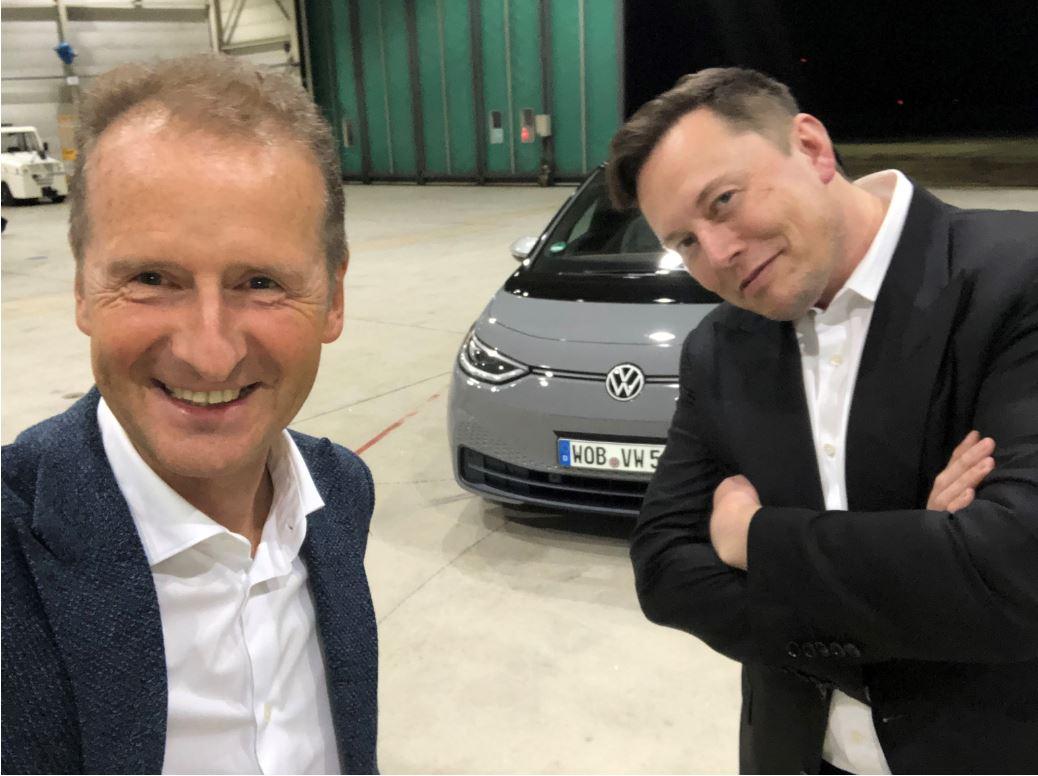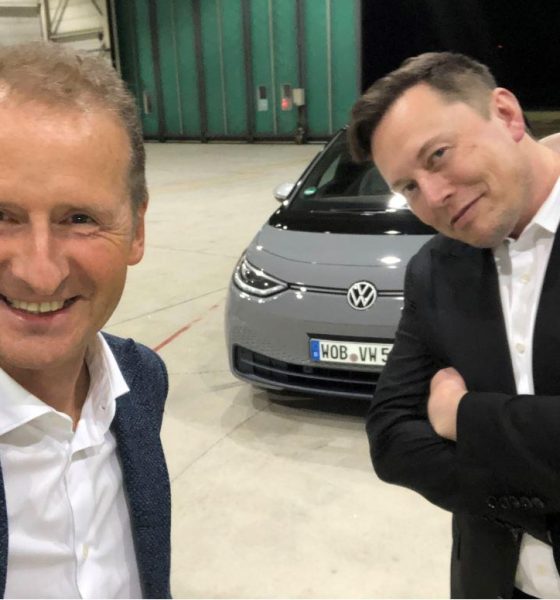

News
Tesla, VW lead the charge for EV dominance as EU sets plan to end combustion engines in 2025
Europe’s current emissions standards have already proven difficult for legacy automakers as evidenced by Honda joining Tesla and Fiat Chrysler’s pool deal recently. But if the EU Commission does decide to push through with its hyper-strict recommended Euro 7 standards, traditional automakers may find it even more difficult to stay competitive in the face of EV manufacturers like Tesla or legacy OEMs who have a leg-up in electric car production and development, like Volkswagen.
All of Tesla’s vehicles are tailor-fit for the strict Euro 7 standards, thanks to its S3XY line, all of which are battery-electric. Tesla recently started exporting Giga Shanghai’s Model 3 vehicle to Europe, thereby increasing its delivery capacity. Gigafactory Berlin seems to be on schedule to start Model Y production in 2021 as well.
On the other side of the aisle, Volkswagen’s ID.3 seems to be selling well in Europe and the ID.4, a crossover, is poised for a release soon. Volkswagen is also working on the other entries of its ID line, such as the ID.5 sedan and estate, the ID.6 SUV, and the ID.7 van. Other all-electric cars from Volkswagen AG, such as the Porsche Taycan and the Audi e-tron, are also being received quite well in their respective segments.
Other traditional OEMs have announced electric vehicles for the future. For instance, Daimler’s Mercedes-Benz brand has announced the EQV, EQS, EQE, and EQA, expanding its existing EV range. Things will likely not be easy for legacy automakers that are only getting their feet wet with EVs, however, as it isn’t just emissions standards that they have to contend with when it comes to releasing new energy vehicles. With each passing year, competitors like Tesla continue to improve the technologies in its vehicles, which also raises the EV standards for traditional OEMs.
The recommendations from the panel of experts in the EU Commissions’ recent study suggests that new car sales in the region will likely be geared towards electric vehicles in the near future. Even if the recommendations end up getting watered down as they are implemented, the shift to electric cars will definitely be palpable within the coming years. And amidst these changes, companies that have already laid the groundwork for their respective electric car programs will likely come out with an advantage.
Tesla would be wise to take advantage of Europe’s apparent war against the combustion engine. With Gigafactory Berlin poised to come online next year, Tesla would have the opportunity to saturate the market with the Model Y, its highest-volume car vehicle to date. The release of the company’s yet-to-be-announced $25,000 EV would also go a long way towards accelerating the mass adoption of all-electric cars. Tesla has not hinted at a concrete release date for its $25,000 car, but with the EU Commission’s stance, it may be a good idea for the electric car maker to accelerate the upcoming vehicle’s release.
Companies like Volkswagen, for their part, would best be advised to ensure that the rollout of its all-electric cars are done with no more delays. The ID.3 experienced severe problems with its software, resulting in the all-electric car’s rollout being pushed back. Amidst Europe’s push to end the internal combustion engine, Volkswagen must ensure that the succeeding vehicles in the ID family are rolled out in a much smoother manner.

News
Tesla aims to combat common Full Self-Driving problem with new patent
Tesla writes in the patent that its autonomous and semi-autonomous vehicles are heavily reliant on camera systems to navigate and interact with their environment.

Tesla is aiming to combat a common Full Self-Driving problem with a new patent.
One issue with Tesla’s vision-based approach is that sunlight glare can become a troublesome element of everyday travel. Full Self-Driving is certainly an amazing technology, but there are still things Tesla is aiming to figure out with its development.
Unfortunately, it is extremely difficult to get around this issue, and even humans need ways to combat it when they’re driving, as we commonly use sunglasses or sun visors to give us better visibility.
Cameras obviously do not have these ways to fight sunglare, but a new patent Tesla recently had published aims to fight this through a “glare shield.”
Tesla writes in the patent that its autonomous and semi-autonomous vehicles are heavily reliant on camera systems to navigate and interact with their environment.

The ability to see surroundings is crucial for accurate performance, and glare is one element of interference that has yet to be confronted.
Tesla described the patent, which will utilize “a textured surface composed of an array of micro-cones, or cone-shaped formations, which serve to scatter incident light in various directions, thereby reducing glare and improving camera vision.”

The patent was first spotted by Not a Tesla App.
The design of the micro-cones is the first element of the puzzle to fight the excess glare. The patent says they are “optimized in size, angle, and orientation to minimize Total Hemispherical Reflectance (THR) and reflection penalty, enhancing the camera’s ability to accurately interpret visual data.”
Additionally, there is an electromechanical system for dynamic orientation adjustment, which will allow the micro-cones to move based on the angle of external light sources.
This is not the only thing Tesla is mulling to resolve issues with sunlight glare, as it has also worked on two other ways to combat the problem. One thing the company has discussed is a direct photon count.
CEO Elon Musk said during the Q2 Earnings Call:
“We use an approach which is direct photon count. When you see a processed image, so the image that goes from the sort of photon counter — the silicon photon counter — that then goes through a digital signal processor or image signal processor, that’s normally what happens. And then the image that you see looks all washed out, because if you point the camera at the sun, the post-processing of the photon counting washes things out.”
Future Hardware iterations, like Hardware 5 and Hardware 6, could also integrate better solutions for the sunglare issue, such as neutral density filters or heated lenses, aiming to solve glare more effectively.
Elon Musk
Delaware Supreme Court reinstates Elon Musk’s 2018 Tesla CEO pay package
The unanimous decision criticized the prior total rescission as “improper and inequitable,” arguing that it left Musk uncompensated for six years of transformative leadership at Tesla.

The Delaware Supreme Court has overturned a lower court ruling, reinstating Elon Musk’s 2018 compensation package originally valued at $56 billion but now worth approximately $139 billion due to Tesla’s soaring stock price.
The unanimous decision criticized the prior total rescission as “improper and inequitable,” arguing that it left Musk uncompensated for six years of transformative leadership at Tesla. Musk quickly celebrated the outcome on X, stating that he felt “vindicated.” He also shared his gratitude to TSLA shareholders.
Delaware Supreme Court makes a decision
In a 49-page ruling Friday, the Delaware Supreme Court reversed Chancellor Kathaleen McCormick’s 2024 decision that voided the 2018 package over alleged board conflicts and inadequate shareholder disclosures. The high court acknowledged varying views on liability but agreed rescission was excessive, stating it “leaves Musk uncompensated for his time and efforts over a period of six years.”
The 2018 plan granted Musk options on about 304 million shares upon hitting aggressive milestones, all of which were achieved ahead of time. Shareholders overwhelmingly approved it initially in 2018 and ratified it once again in 2024 after the Delaware lower court struck it down. The case against Musk’s 2018 pay package was filed by plaintiff Richard Tornetta, who held just nine shares when the compensation plan was approved.
A hard-fought victory
As noted in a Reuters report, Tesla’s win avoids a potential $26 billion earnings hit from replacing the award at current prices. Tesla, now Texas-incorporated, had hedged with interim plans, including a November 2025 shareholder-approved package potentially worth $878 billion tied to Robotaxi and Optimus goals and other extremely aggressive operational milestones.
The saga surrounding Elon Musk’s 2018 pay package ultimately damaged Delaware’s corporate appeal, prompting a number of high-profile firms, such as Dropbox, Roblox, Trade Desk, and Coinbase, to follow Tesla’s exodus out of the state. What added more fuel to the issue was the fact that Tornetta’s legal team, following the lower court’s 2024 decision, demanded a fee request of more than $5.1 billion worth of TSLA stock, which was equal to an hourly rate of over $200,000.
Delaware Supreme Court Elon Musk 2018 Pay Package by Simon Alvarez
News
Tesla Cybercab tests are going on overdrive with production-ready units
Tesla is ramping its real-world tests of the Cybercab, with multiple sightings of the vehicle being reported across social media this week.

Tesla is ramping its real-world tests of the Cybercab, with multiple sightings of the autonomous two-seater being reported across social media this week. Based on videos of the vehicle that have been shared online, it appears that Cybercab tests are underway across multiple states.
Recent Cybercab sightings
Reports of Cybercab tests have ramped this week, with a vehicle that looked like a production-ready prototype being spotted at Apple’s Visitor Center in California. The vehicle in this sighting was interesting as it was equipped with a steering wheel. The vehicle also featured some changes to the design of its brake lights.
The Cybercab was also filmed testing at the Fremont factory’s test track, which also seemed to involve a vehicle that looked production-ready. This also seemed to be the case for a Cybercab that was spotted in Austin, Texas, which happened to be undergoing real-world tests. Overall, these sightings suggest that Cybercab testing is fully underway, and the vehicle is really moving towards production.
Production design all but finalized?
Recently, a near-production-ready Cybercab was showcased at Tesla’s Santana Row showroom in San Jose. The vehicle was equipped with frameless windows, dual windshield wipers, powered butterfly door struts, an extended front splitter, an updated lightbar, new wheel covers, and a license plate bracket. Interior updates include redesigned dash/door panels, refined seats with center cupholders, updated carpet, and what appeared to be improved legroom.
There seems to be a pretty good chance that the Cybercab’s design has been all but finalized, at least considering Elon Musk’s comments at the 2025 Annual Shareholder Meeting. During the event, Musk confirmed that the vehicle will enter production around April 2026, and its production targets will be quite ambitious.








